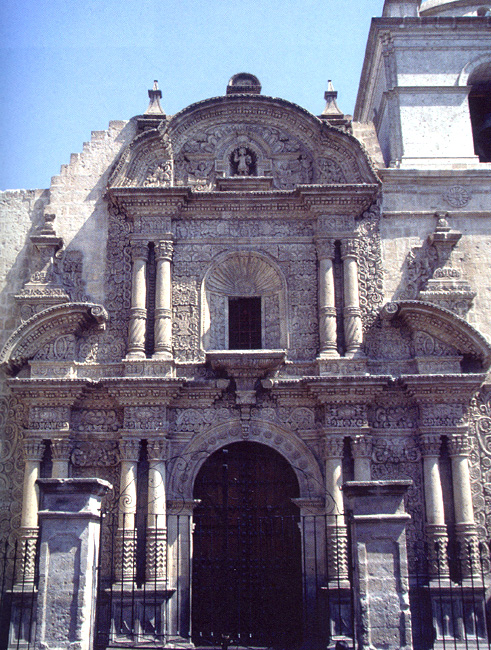
Andean Hybrid Baroque (1) |
 |
|---|
Source: Gauvin Alexander Bailey, The Andean Hybrid Baroque; Convergent Cultures in the Churches of Colonial Peru. Notre Dame, Indiana: University of Notre Dame Press, 2010, plate 2.3. "The façade incorporates almost the full repertoire of Andean Hybrid Baroque motifs. The lower story is flanked by giant carved borders composed of serpentine monsters with massive jaws—figuras parlantes—that emerge from scrolling vines that scholars have compared to centipede bodies [...]. These creatures disgorge cactus flowers, pomegranates, tobacco-like leaves, cantuta scrolls, and mustachioed monster masks with vines emerging from their mouths [...]. Just inside these serpentine cornucopias is an eight-link chain containing four- and eight-petal rosettes and crowned with a shell. Richly carved panels adorn the space between the columns [...]. At the top of each is a winged cherub with cantuta blossoms dangling from its wings and resting on cactus flowers, grapes, and pomegranates. Below is a pair of crests bearing the inscriptions "EL AÑO" on the left) and "DE 1698" (on the right). The crests are surrounded by tobacco-like leaves with triple feather plumes at the top, and they rest on the shoulders of a long-haired male caryatid holding two bunches of grapes, his upper body dissolving into leaves and a pomegranate. The lowest part of the panel frames a double-handled vase of scrolling flowers inhabited by four small songbirds. The relatively plain doorway has rosette voussoirs [truncated wedge-shaped pieces that form an arch or vault] and a scrolling, corbel-like keystone, common throughout the southern Andes" (pp. 52-53). |
|---|